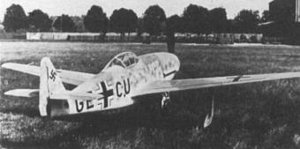Messerschmitt Me 309 Video - Scale RC Model Prototype
|
|
Messerschmitt Me 309
Me 309

Picture - Me 309
Role: Fighter
Manufacturer: Messerschmitt
Designed by: Willy Messerschmitt
First flight: 18 July 1942
Retired: 1943
Status: Experimental
Primary user: Luftwaffe
Number built: 4
Developed from: Messerschmitt Bf 109
The Messerschmitt Me 309 was a prototype German fighter designed in the early years of World War II to replace the Bf 109. Although it had many advanced features, the Me 309's performance left much to be desired and it suffered from so many problems that the project was cancelled with only four prototypes built. The Me 309 was one of two failed Messerschmitt projects intended to replace the aging Bf 109, the other being the Me 209-II.
Design and development
The Me 309 project began in mid-1940, just as the Bf 109 was having its first encounters with the Spitfire in the Battle of Britain, the first aircraft to match the 109 in speed and performance. Already, Messerschmitt anticipated the need for an improved design to replace the Bf 109. The Reich Air Ministry, however, did not feel the same urgency, with the project given a low priority resulting in the design not being finalized until the end of 1941.
The new fighter had many novel features, such as tricycle landing gear (with a nose gear strut that twisted through 90º during retraction, to a "flat" orientation under the engine) and a pressurized cockpit, which would have given it more comfortable and effective high-altitude performance. Each of the new features was first tested on a number of Bf 109F airframes, the V23 having a ventral radiator, the V31 with radiator and tricycle landing gear, and the V30 having a pressurized cockpit.
Low government interest in the project delayed completion of the first prototype until spring 1942, and trouble with the nose wheel pushed back the 309's first flight to July. When it did fly, the Me 309's performance was satisfactory - about 50 km/h (30 mph) faster than a standard Bf 109G - but not exemplary. In fact, the Bf 109G could out-turn its intended replacement. With the addition of armament, the aircraft's speed decreased to an unacceptable level. In light of its poor performance and the much more promising development of the Focke-Wulf Fw 190D, the Me 309 was canceled.
In 1943, Messerchmitt made one last attempt at creating a replacement for the Bf 109 in the form of the Me 209-II. It was essentially a modification of the existing 109 airframe, Messerschmitt designers not wanting to invest the time and trouble in a new design like the Me 309.
Specifications (Me 309)
General characteristics
Crew: 1, pilot
Length: 9.46 m (31 ft 0 in)
Wingspan: 11.04 m (36 ft 3 in)
Height: 3.90 m (12 ft 10 in)
Wing area: 16.6 m² (179 ft²)
Empty weight: 3,530 kg (7,766 lb)
Loaded weight: 4,250 kg (9,350 lb)
Powerplant: 1x— Daimler-Benz DB 603G, 1,308 kW (1,750 hp)
Performance
Maximum speed: 733 km/h (457 mph)
Range: 1,100 km (686 mi)
Service ceiling: 12,000 m (39,360 ft)
Wing loading: 256 kg/m² (52 lb/ft²)
Power/mass: 0.31 kW/kg (0.19 hp/lb)
Armament
2 x— 15 mm (.59 in) MG 151 cannons
3 x— 13 mm (.51 in) MG 131 machine guns
Related development
Bf 109
Me 209
Me 209-II
Me 409
Me 509
Me 609
Green, William. War Planes of the Second World War, Fighters, vol. I. London: Hanover House, 1960.
Jackson, Robert. Infamous Aircraft: Dangerous Designs and their Vices. Barnsley, Yorkshire, UK: Pen and Sword Aviation, 2005. ISBN 1-84415-172-7.
Messerschmitt Me 309 Pictures
Living Warbirds: The best warbirds DVD series.
Source: WikiPedia